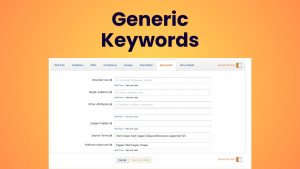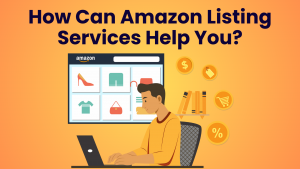From Click to Cart: How to Optimize Your Amazon Product Listings for Sales
From Click to Cart: How to Optimize Your Amazon Product Listings for Sales
Blog Article
Introduction
You cannot just upload your product listing without a care in the world, leaving out keywords and hoping it rises to the top of search results. The Amazon A9 algorithm will ensure your listing stays at the bottom of the search results if it isn’t optimized. So, you may ask, “What does optimization mean?”. Optimization ensures all parts of your product listing satisfy the algorithm. You require generic, alt, title keywords, and product description keywords to get your listing indexed on Amazon. However, it is not all about keywords. Compelling copywriting and enhanced visuals are just as important. Therefore, Amazon listing optimization refers to optimizing copywriting and other listing aspects.
[TOC]
Analyze Your Competitors

The first part of listing optimization is competitor analysis. You must find competitors selling the same product. Check out their copywriting, title, EBC, and images. See how many reviews they have and what customers say about their product. Research every aspect to identify key customer concerns and product issues. Before optimization, it is essential to figure out all problems. Listing optimization is more impactful if it considers every bit of information. Therefore, learn everything you can about your competitor. Identify commonly used keywords on their listing. Moreover, find out the demographic from the reviews and determine what your customers want. Optimize the listing based on the demands of customers and the market.
After analyzing strengths, you must also recognize the weaknesses of your competitors. Identify the gaps in their product listings. Check out bad reviews and make your product better. Maybe your competitors are getting bad reviews because they are stating incorrect sizes and colors. Perhaps their bullet points are too vague, missing important details buyers want. If their images are low-quality or fail to showcase the product in a real-life setting, you can swoop in with professional, lifestyle-focused pictures that resonate with customers. Zero in on the weak spots of your competitors!
Read More: Harnessing AI for Stunning Product Visuals: Enhancing Your Amazon Listings
Keyword Research & Copywriting

Keyword research is the backbone of listing optimization. You cannot optimize the product listing when you aren’t aware of the best-selling high-ranking keywords. Use tools such as H10’s Cerebro to find keywords. Find out which keywords best describe your product. Dig deeper to find more relevant long-tail keywords. For instance, if you’re selling a vegan protein powder, you might want to prioritize keywords like “plant-based protein for smoothies” or “gluten-free protein powder” over broader terms like “protein powder.” Focus on the targeted keywords and attract shoppers who want that product. Remember, the more precise your keywords are to your product, the better you’ll connect with your ideal customers.
Your product title should have at least three keywords. Two of these keywords should be long-tail keywords specific to your product, helping you attract a more targeted audience. For example, if you’re selling a “vegan collagen booster,” your title might include keywords like “plant-based collagen supplement” and “vegan skin health booster” to reach customers looking for exactly those features. You only need one keyword per bullet point to maximize readability and visibility on Amazon. Choose keywords that align with each point’s focus, like “hydration support” or “collagen-building ingredients.”
Read More: How to Do Innovative Amazon Product Research
Generic Keywords

Amazon provides a 500-character field for generic keywords, enhancing your product listing visibility. Add keywords that you couldn’t add in the copywriting. You could include product features and other relevant terms in the generic keywords field. Do not insert keywords that have already been used in the copywriting. You’ll be wasting the space for generic keywords. Keep the keywords relevant even if they are unreadable. However, do not fill this space with irrelevant terms or incorrect terms. Amazon might lower your product listing visibility if the generic keywords are irrelevant.
Amazon allows you to upload alt text for listing and EBC images, helping you get better visibility. Alt text is essential for describing your pictures to the search engine. Use highly relevant keywords as alt-text keywords to increase your traffic. Enhance your Amazon SEO while providing a better shopping experience for customers.
Read More: How to Structure Your Listing (UPDATES)
How Can Amazon Listing Services Help You?

An Amazon listing creation service is necessary for sellers who want a polished, high-performing listing without the guesswork. These experts know where to place the right keywords for maximum visibility, ensuring your title, bullet points, and description align perfectly with Amazon’s search algorithms. They’re also well-versed in terms and phrases that should be avoided, helping you dodge any red flags that could get your listing flagged or suppressed. They can create a fully optimized listing quickly and efficiently so your product gets up and running with all the right parameters.
The Amazon product listing optimization service will significantly improve your sales, allowing you to focus on other parts of the business. The first step for optimizers is an in-depth audit of the current listings because it helps identify deficiencies and missed opportunities. The analysis examines various elements, including your title, bullet points, product descriptions, images, and keyword usage. Poor keyword optimization and unclear copywriting are common reasons for an unoptimized product listing. Professional assistance will help you transform your listings from mediocre to magnetic without the hassle of doing it yourself.
Amazon listing optimization helps improve Amazon rankings, linking it directly to sales. It makes your listing more visible, engaging, and compelling, encouraging customers to choose your product. An optimized listing improves your chances of appearing in search results, putting your product in front of more shoppers. However, visibility is not the only metric that matters. An Amazon listing expert ensures customers buy your product when they land on it. Optimized listings have catchy copywriting and concise information, helping customers to make an informed buying decision.
Listing optimization often includes strategic use of Enhanced Brand Content (EBC) or A+ Content, which can further enhance your product page with engaging visuals and brand storytelling. All these elements work together to create a seamless shopping experience, ultimately boosting conversion rates and driving more sales.
Read More: Amazon Product Ranking: How To List, Index, and Use Keywords?
Why Should You Outsource Amazon Listing Optimization Services?
Amazon listing optimization professionals understand the intricacies of Amazon’s A9 algorithm, which determines how products rank in search results. They know which elements—such as keyword placement, image selection, and backend keywords—will improve your listing’s ranking. It means they can make targeted improvements to increase your product’s visibility and attract more customers.
Optimizing a listing can take hours—or even days—if you’re unsure where to start. Let the listing optimization team handle the research, copywriting, image recommendations, and more, delivering a polished, ready-to-go listing without lifting a finger.
Experienced listing optimizers know how to create a persuasive, sales-driven copy. They can craft a product title, bullet points, and description that include the right keywords while effectively communicating the unique benefits and product features. The result is a highly appealing and search-friendly product listing.
Listing optimization services often have access to premium tools that provide insights into search trends, competitor strategies, and performance analytics. These tools enable the team to continually monitor and adjust your listing based on data, ensuring it stays optimized even as market trends and customer preferences evolve.
As competition on Amazon grows, having an expertly optimized listing can give you an advantage over other sellers in your niche. Optimization services ensure your listing is crafted to attract and convert more customers, helping you stand out and capture a larger market share.
Case Study
According to our case study, a simple tweak to a product title led to a significant boost in sales. The original title was generic and lacked specific keywords that matched the search intent of Amazon shoppers. We removed the brand name from the title, and it increased the product visibility, significantly increasing sales. This case demonstrates that even small adjustments, when guided by a strategic approach, can have a powerful impact on sales performance. Sometimes, it is not about overhauling the entire listing but about knowing where to make the appropriate enhancements to capture the attention of your target audience.
Why Do You Need Listing Optimization?
Product listing optimization is not an optional enhancement nowadays. It is a necessity for maximizing sales potential. Optimizing your listing helps you attract more traffic by improving your search rankings. The higher you rank, the more likely your product is to be seen by the right customers, which impacts sales. An optimized listing communicates your product’s value quickly and persuasively, helping buyers make faster purchasing decisions. Well-crafted copy, engaging visuals, and strategic keyword placement increase your conversion rate, transforming more clicks into sales.
Common Mistakes to Avoid
Packing your title, bullets, and description with keywords might seem like a good idea to boost visibility, but it can backfire. Keyword-stuffed copy looks unprofessional, is difficult to read, and can drive potential customers away. Amazon’s algorithm favors readability and relevancy over sheer keyword density. Focus on naturally integrating keywords where they make sense and enhance the flow of your copy.
Images are one of the most influential aspects of an Amazon listing, yet many sellers overlook them by uploading low-resolution or uninspiring photos. Blurry, unclear, or inadequate images fail to convey product quality and may cause shoppers to skip over your listing. Always use high-resolution images that showcase your product from multiple angles, include lifestyle shots, and use Amazon’s 7-image limit to provide a comprehensive view of your product.
Overpromising or exaggerating product capabilities leads to negative reviews and high return rates. You want to highlight benefits while being honest about what your product does (and doesn’t do). Set accurate expectations and focus on genuine features and benefits, ensuring customers know what they’re getting.
Sellers hardly use Amazon’s backend keywords appropriately. Skipping this section means you are missing out on extra visibility. You need to optimize your product listing for relevant search terms.
Amazon has specific rules about words and phrases that can’t be used in listings, particularly those that make health claims, reference competitors, or violate safety regulations. Incorporating these terms in listing images, copywriting, or product videos results in listing suppression or account suspension. Familiarize yourself with Amazon’s restricted terms list to ensure your copy stays compliant.
Most Amazon shoppers use mobile devices, but listings that aren’t optimized for mobile can lead to a poor user experience. Long paragraphs, lack of concise bullet points, and unclear images can be challenging to navigate on a smaller screen. Optimize your copy for mobile by using short, punchy bullet points and ensuring that your main images are clear and impactful at a reduced size.
Read More: How Keywords, Copy, and Visuals Work Together on Amazon
Measuring the Success of Optimized Listings
Your conversion rate tells you the percentage of people who purchase your product after viewing your listing. This metric is a significant indicator of how well your listing resonates with potential buyers. If your conversion rate increases after optimization, it is a sign that the new copy, keywords, and visuals are persuading visitors to buy.
The CTR measures the percentage of people who click on your listing after seeing it in search results. A high CTR usually means that your title, price, and main image are appealing and relevant. If your optimized listing achieves a higher CTR, it is likely because your title and main image are more engaging and you are targeting the right keywords.
Monitor the organic ranking for your target keywords. If you see your listing ranking higher in search results over time, your optimization efforts—such as keyword placement and relevance—are working. Improved rankings bring more organic traffic and reduce your reliance on paid ads, which helps your bottom line.
An increase in sales and revenue is the ultimate sign of successful optimization. You can monitor your total units sold and the revenue generated over time to determine if your listing optimization is making a tangible impact on your sales performance. Compare these figures with your pre-optimization numbers to assess growth.
Measure your results, refine as needed, and keep your listing up-to-date with changing trends. With a well-optimized Amazon listing, you’re not just boosting sales for the short term; you’re establishing a strong foundation for long-term success. So, take the steps now to transform clicks into sales and watch your Amazon business reach new heights! Report this page